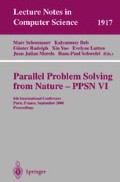Abstract
When handling tree networks, researchers have sometimes tried using the Pruefer number representation for encoding networks, however GAs often degraded when used on this encoding.
This paper investigates the locality of the Pruefer number and its affect on the performance of a Genetic Algorithm (GA). The locality describes how the neighborhood of the genotype is preserved when constructing the phenotype (the tree) from the genotype (the Pruefer number). It is shown that the locality of the Pruefer number is highly irregular on the entire solution space, and that the performance of a GA depends on the structure of the optimal solution. A GA is able to perform well only for networks that have a high locality (stars). For all other types of networks (lists, trees) the locality is low and a GA fails to find the best list or tree. Using a GA with the Pruefer number encoding can be useful, when the best solution tends to be a star.
The locality of an encoding could have a strong influence on the performance of a GA. When choosing encodings for optimization problems, researchers should be aware of this and be careful with low locality encodings. If the locality of the encoding is low, a failure of the GA is often unavoidable.
Access this chapter
Tax calculation will be finalised at checkout
Purchases are for personal use only
Preview
Unable to display preview. Download preview PDF.
References
Abuali, F. N., Wainwright, R. L., & Schoenefeld, D. A. (1995). Determinant factorization: A new encoding scheme for spanning trees applied to the probabilistic minimum spanning tree problem. In Eschelman, L. (Ed.), Proceedings of the Sixth International Conference on Genetic Algorithms (pp. 470–477). San Francisco, CA: Morgan Kaufmann.
Bäck, T., & Schwefel, H.-P. (1995). Evolution strategies I: Variants and their computational implementation. In Winter, G., Périaux, J., Galán, M., & Cuesta, P. (Eds.), Genetic Algorithms in Engineering and Computer Science (Chapter 6, pp. 111–126). Chichester: John Wiley and Sons.
Gen, M., Ida, K., & Kim, J. (1998). A spanning tree-based genetic algorithm for bicriteria topological network design. See Institute of Electrical and Electronics Engineers (1998), pp. 15–20.
Gen, M., Zhou, G., & Takayama, M. (1998). A comparative study of tree encodings on spanning tree problems. See Institute of Electrical and Electronics Engineers (1998), pp. 33–38.
Goldberg, D. E. (1989). Genetic algorithms in search, optimization, and machine learning. Reading, MA: Addison-Wesley.
Institute of Electrical and Electronics Engineers (Ed.) (1998). Proceedings of 1998 IEEE International Conference on Evolutionary Computation. Piscataway, NJ: IEEE Service Center.
Julstrom, B. A. (1993). A genetic algorithm for the rectilinear steiner problem. In Forrest, S. (Ed.), Proceedings of the Fifth International Conference on Genetic Algorithms (pp. 474–480). San Mateo, CA: Morgan Kaufmann.
Palmer, C. C. (1994). An approach to a problem in network design using genetic algorithms. unpublished PhD thesis, Polytechnic University, Troy, NY.
Palmer, C. C, & Kershenbaum, A. (1994). Representing trees in genetic algorithms. In Proceedings of the First IEEE Conference on Evolutionary Computation, Volume 1 (pp. 379–384). Piscataway, NJ: IEEE Service Center.
Pruefer, H. (1918). Neuer beweis eines satzes ueber permutationen. Arch. Math. Phys., 27, 742–744.
Author information
Authors and Affiliations
Editor information
Editors and Affiliations
Rights and permissions
Copyright information
© 2000 Springer-Verlag Berlin Heidelberg
About this paper
Cite this paper
Rothlauf, F., Goldberg, D.E. (2000). Pruefer Numbers and Genetic Algorithms: A Lesson on How the Low Locality of an Encoding Can Harm the Performance of Gas. In: Schoenauer, M., et al. Parallel Problem Solving from Nature PPSN VI. PPSN 2000. Lecture Notes in Computer Science, vol 1917. Springer, Berlin, Heidelberg. https://doi.org/10.1007/3-540-45356-3_39
Download citation
DOI: https://doi.org/10.1007/3-540-45356-3_39
Publisher Name: Springer, Berlin, Heidelberg
Print ISBN: 978-3-540-41056-0
Online ISBN: 978-3-540-45356-7
eBook Packages: Springer Book Archive

